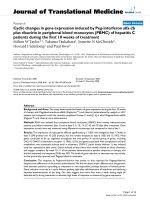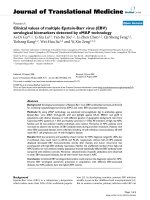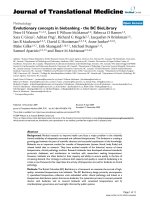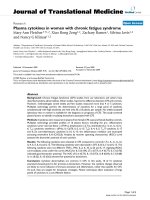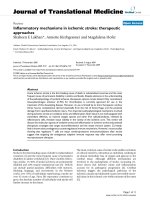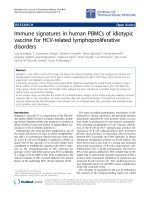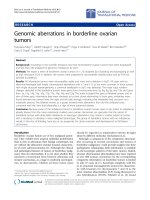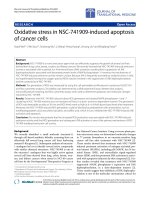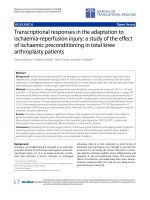báo cáo hóa học: " Fatigue characteristics in multiple sclerosis: the North American Research Committee on Multiple Sclerosis (NARCOMS) survey" pot
Bạn đang xem bản rút gọn của tài liệu. Xem và tải ngay bản đầy đủ của tài liệu tại đây (380.29 KB, 11 trang )
BioMed Central
Page 1 of 11
(page number not for citation purposes)
Health and Quality of Life Outcomes
Open Access
Research
Fatigue characteristics in multiple sclerosis: the North American
Research Committee on Multiple Sclerosis (NARCOMS) survey
Olympia Hadjimichael
1
, Timothy Vollmer
2
and MerriKay Oleen-Burkey*
3
Address:
1
Department of Neurology, Yale University School of Medicine, New Haven, CT 06510, USA,
2
Barrow Neurological Institute, CMSC/
NARCOMS Project, Phoenix, AZ 85013, USA and
3
Health Economics and Outcomes Research, Teva Neuroscience, Inc., Kansas City, MO 64131,
USA
Email: Olympia Hadjimichael - ; Timothy Vollmer - ; MerriKay Oleen-
Burkey* -
* Corresponding author
Abstract
Background: Fatigue is a common disabling symptom of multiple sclerosis (MS) and has a
significantly negative impact on quality of life. Persons with MS enrolled in the North American
Research Committee on Multiple Sclerosis (NARCOMS) Patient Registry are invited to complete
follow-up surveys every six months to update their original registration information. One of these
surveys was designed to focus on the severity and impact of fatigue, and its association with other
clinical parameters of MS such as physical disability.
Methods: In addition to the usual data collected in Registry update surveys such as demographic
characteristics, MS-related medical history, disability and handicap, immunomodulatory and
symptomatic therapies taken, and healthcare services used, the survey for this study included two
validated self-report fatigue scales, the Fatigue Severity Scale (FSS) and the Modified Fatigue Impact
Scale (MFIS) and questions about the use of symptomatic management for fatigue, both
pharmacologic and non-pharmacologic treatments. This Registry update survey was mailed to all
NARCOMS registrants (n = 18,595) in November 2002. Information provided by registry
participants was approved for research purposes by the Yale University Institutional Review Board.
Results: The response rate for the survey was 49.5% (9205/18,595). Severe fatigue as measured
with the FSS using the developer's recommended severity cutpoint of ≥ 36 was reported by 6691
(74%) of evaluable respondents (n = 9077). A higher prevalence of severe fatigue was observed in
relapsing-worsening MS compared with relapsing-stable and primary progressive MS. A distinct
pattern of fatigue was observed across the disability levels of the Patient-Determined Disease Steps
(PDDS). Although there were no differences in the severity or impact of fatigue by
immunomodulatory agents (IMA), respondents who recalled therapy changes in the prior six
months reported different patterns of change in fatigue with lower fatigue levels reported after
changing from interferon-β to glatiramer acetate than after changing from glatiramer acetate to
interferon-β. Concomitant therapy for fatigue was used by 47.2% of the 5799 survey respondents
receiving IMA.
Conclusion: Characterizing MS symptoms like fatigue can increase awareness about their impact
on persons with MS and suggest recommendations for a care plan.
Published: 14 November 2008
Health and Quality of Life Outcomes 2008, 6:100 doi:10.1186/1477-7525-6-100
Received: 30 April 2008
Accepted: 14 November 2008
This article is available from: />© 2008 Hadjimichael et al; licensee BioMed Central Ltd.
This is an Open Access article distributed under the terms of the Creative Commons Attribution License ( />),
which permits unrestricted use, distribution, and reproduction in any medium, provided the original work is properly cited.
Health and Quality of Life Outcomes 2008, 6:100 />Page 2 of 11
(page number not for citation purposes)
Background
Chronic fatigue is one of the most common disabling
symptoms among persons with multiple sclerosis (MS),
interfering with, and considerably limiting, daily activities
[1,2]. At least 65% of persons with MS experience fatigue
on a daily basis, usually during the afternoons [3-6], and
15%–40% report it as the most disabling MS symptom
[4,5,7-9]. MS fatigue is different from fatigue in healthy
subjects [7,10], difficult to define, and therefore one of the
most challenging symptoms to treat. No biologic or
neuro-imaging markers for fatigue are currently known,
and its pathophysiology and etiology are poorly under-
stood. Both peripheral and central mechanisms may have
a role [11-15].
Fatigue has a significant negative impact on daily work,
family life, and social activities of persons with MS and is
associated with the perception of an impaired general
health, mental state, and quality of life (QOL) [16-18]. It
appears to have an even more important effect on QOL
than physical disability alone [18-20]. Studies of fatigue
in association with other MS clinical characteristics, such
as physical disability [8,21,22], depression [21,22], or dis-
ease subtype [4,8,9,21], report contradictory findings.
Symptomatic management of MS fatigue includes both
non-pharmacologic treatments, such as exercise and keep-
ing cool [1], as well as pharmacologic treatments, such as
amantadine and modafinil [2].
The current study examined the characteristics of fatigue
among persons with MS in the North American Research
Committee on Multiple Sclerosis (NARCOMS) Patient
Registry, a project of the Consortium of MS Centers
(CMSC). A longitudinal database initiated in 1996, the
Registry is a resource for clinical trials and long-term pro-
spective studies [23-27]. As of 2008, the Registry is com-
prised of more than 33,000 patients and provides a
unique opportunity to study MS characteristics and treat-
ment patterns in a large population of persons with MS.
The aims of this study were to: (1) evaluate the severity
and impact of fatigue among NARCOMS registrants and
characterize the differences between those reporting mild/
moderate fatigue and severe fatigue; (2) assess the associ-
ation between the severity and impact of fatigue and phys-
ical disability; (3) investigate respondents' perceptions of
fatigue levels when changing immunomodulatory agents
(IMA); and (4) evaluate the prevalence and pattern of
symptomatic management of fatigue.
Methods
Persons with MS living in the US are recruited voluntarily
to the NARCOMS registry through the registry's website,
the National MS Society, MS centers, and support groups.
The validity of the MS diagnosis was recently confirmed in
98.7 ± 1.3% of the validation sample [28]. Data collected
in the registry include demographic information, MS-
related medical history, disability and handicap, immu-
nomodulatory and symptomatic therapies taken, and
healthcare services used. Following enrollment, the Regis-
try is updated with surveys that are sent to participants
every 6 months [23,24]. The current study is based on a
single Registry update survey that was mailed to all NAR-
COMS registrants (n = 18,595) in November 2002. Infor-
mation provided by registry participants was approved for
research purposes by the Yale University Institutional
Review Board (IRB). The IRB granted approval for an
information statement in lieu of formal informed con-
sent. The Information Page accompanying each survey
requested a participant's signature to acknowledge the
intended use of the information and was worded as fol-
lows: "By signing below, I give my permission for the fol-
lowing information to be entered into the NARCOMS MS
Registry. I understand that this information will be used
for research purposes only, and that all responses will be
kept private and confidential. I am willing to be notified
of any studies for which I may be eligible."
This Registry update survey included a special section on
fatigue. The most reliable and valid fatigue measures, the
Modified Fatigue Impact Scale (MFIS) and the Fatigue
Severity Scale (FSS) [4,29,30], were incorporated into the
survey, along with a question designed to capture the reg-
istrants' perceptions of fatigue levels following changes
from one IMA to another when that had occurred in the
previous six months.
Survey measures
MS-subtype
Participants in the NARCOMS registry are assigned a dis-
ease subtype based on the presence of relapses in the
course of their disease and their disease progression. The
first MS subtype, primary progressive disease, is defined as
continuous accumulation of disability with no relapses
throughout the disease course. Relapsing-stable disease is
defined as having a relapse anytime throughout the dis-
ease course and reporting a disability state that is
improved or similar to that observed a year earlier. Relaps-
ing-worsening disease is defined as having a relapse any-
time throughout the disease course and reporting a
disability state that has worsened during the previous
year.
Fatigue
The impact of fatigue on the respondent's daily activities
was assessed with the MFIS, a 21-item scale that defines
fatigue as a "feeling of physical tiredness and lack of
energy that many people experience from time to time"
[4,30]. Each item is rated by the respondent on a scale
Health and Quality of Life Outcomes 2008, 6:100 />Page 3 of 11
(page number not for citation purposes)
from 0 (never) to 4 (almost always). Scores are calculated
for each of its three subscales: – physical (9 items, cumu-
lative score range 0–36), cognitive (10 items, cumulative
score range 0–40), and psychosocial (2 items, cumulative
score range 0–8), and combined for a total MFIS score
(range 0–84) [4,30].
Fatigue severity was measured with the FSS, a 9-item scale;
each item is rated on a scale from 1 (strongly disagree) to
7 (strongly agree) with the total score ranging from 9–63
[29]. The scale developer defines severe fatigue as an FSS
score ≥ 36 (an average of ≥ 4 across the nine questions)
while mild/moderate fatigue is defined as FSS < 36
[29,31].
Mobility and neurologic impairment
Neurologic impairment and mobility status were assessed
in the survey using two validated self-report instruments
which are included in each Registry update survey.
Performance Scales are a measure of handicap in twelve
domains of neurologic function: mobility, hand function,
vision, fatigue, cognition, bladder/bowel, sensory, spastic-
ity, pain, depression, tremor/loss of coordination, and
anxiety. All domains except mobility are assessed by
respondents on a scale of 0 (normal) to 5 (total disabil-
ity). Mobility is measured on a 0 (normal) to 6 (total gait
disability) scale [32].
Mobility impairment was measured with the Patient-
Determined Disease Steps (PDDS), which uses a 0 (nor-
mal) to 8 (bedridden) scale [32,33]. The PDDS, although
self-reported, is highly correlated with the physician-
reported Kurtzke Expanded Disability Status Scale (EDSS)
[34], and defines more precisely than the EDSS mid-range
mobility. These scales were used to assess the correlation
between PDDS and fatigue level, as well as the differences
in fatigue levels based on the PDDS.
Fatigue and changes in IMA
The impact and severity of fatigue were examined relative
to treatment with IMA along with the level of fatigue asso-
ciated with changes in IMA. IMA included glatiramer ace-
tate (Copaxone
®
) and the interferons: IFN-β-1a (Avonex
®
and Rebif
®
), and IFN-β-1b (Betaseron
®
). Fatigue associ-
ated with therapy change was assessed with a scale of 1
(much less) to 7 (much greater), with a higher score indi-
cating a higher level of fatigue following the change in
therapy. A regression analysis was conducted to assess fac-
tors that could contribute to a change in fatigue under
these circumstances.
Symptomatic treatments of fatigue
The use of symptomatic treatments for fatigue, both phar-
macologic and non-pharmacologic, was collected in the
survey. Non-pharmacologic treatment options included
the use of an exercise program and physical and occupa-
tional therapy.
Statistical analysis
Statistical analysis was performed using descriptive statis-
tical techniques. Logistic regression was used to determine
odds ratio estimates of the strength of the association
between each dichotomous independent variable and the
fatigue score, after controlling for the other variables in
the model (age, use of symptomatic drugs, PDDS, dura-
tion of IMA use, disease duration, and disease subtypes).
In addition, a separate regression analysis was conducted
to assess factors that may contribute to changes in fatigue
level after changes in IMAs.
Results
The surveys were completed by 9205 (49.5%) registrants.
To be evaluable, the survey had to have all fatigue ques-
tions answered and the respondent had to report treat-
ment with an IMA or be treatment-naïve (n = 9077). The
registrants who did not respond to the survey were similar
to the respondents in mean age, gender distribution, dis-
ease duration, and education. The majority (65%) of the
non-responders had been classified as having relapsing-
worsening MS on the last completed Registry survey, and
their mean PDDS score was 3.78 (early cane).
Fatigue severity and impact
On the basis of the FSS scores, respondents were catego-
rized into two levels of fatigue: mild/moderate (< 36) or
severe (≥ 36) fatigue. Nearly 74% of the sample reported
severe fatigue. As shown in Table 1 those with severe
fatigue were more likely to be older, male, with an educa-
tion level of associate degree or less, unemployed, diag-
nosed at an older age, and report more disability on the
PDDS (p < .0001) than those with mild/moderate fatigue.
Only 29.0% of those with severe fatigue reported being
employed compared to 54.6% of those with mild/moder-
ate fatigue. The level of fatigue also differed between the
MS disease subtypes. A higher prevalence of severe fatigue
was observed in persons with relapsing-worsening MS
(59.8%) than among the other two subtypes. More
respondents with severe fatigue (46.5%) were treated with
symptomatic drugs than those with mild/moderate
fatigue (18.2%).
The impact of fatigue as measured with the MFIS was
notably higher among those with severe fatigue as shown
in Table 2. The mean total MFIS score as well as each of
the mean MFIS subscale scores for physical, cognitive, and
psychosocial fatigue were more than twice as high among
those with severe fatigue as among those with mild/mod-
erate fatigue. Correspondingly, respondents with relaps-
ing-worsening disease who were shown to have the most
Health and Quality of Life Outcomes 2008, 6:100 />Page 4 of 11
(page number not for citation purposes)
severe fatigue also had a higher mean total MFIS score
(51.3 ± 15.9)compared to those with relapsing-stable
(36.8 ± 18.3) and primary progressive (36.9 ± 18.9) MS.
When mean fatigue scores on the MFIS and FSS were
examined relative to the duration of MS, they were shown
to sharply increase for about the first 14 years of disease
duration, after which they leveled off in terms of both
impact (MFIS) and severity (FSS).
A logistic regression analysis of several factors thought to
predict fatigue among the NARCOMS respondents
showed that the use of symptomatic drugs for fatigue was
a strong predictor while PDDS was a weak predictor for
experiencing fatigue (Table 3). Having relapsing-stable or
primary progressive MS rather than relapsing-worsening
MS was predictive of lower fatigue. Age, duration of IMA
therapy, and disease duration showed no predictive
power.
Fatigue and MS disability
Mean fatigue scores measuring impact (MFIS) and severity
(FSS) were found to follow similar patterns across the lev-
els of physical disability on the PDDS (Figure 1). Fatigue
scores increased steadily as respondents' functional levels
changed from no limitations, to abnormal gait. From that
point on up to wheelchair mobility, fatigue impact and
severity remained stable. However, respondents who were
bedridden reported the most severe fatigue, on average, of
any disability category and the impact of that fatigue as
measured by the MFIS was also at its highest point.
Neurologic impairment, as reflected in the mean scores of
all twelve domains of the Performance Scales, including
depression, was consistently statistically significantly
higher (p < .0001) in respondents with severe fatigue com-
pared with those reporting mild/moderate fatigue. The
following scores show the differences between severe
fatigue and mild/moderate fatigue, respectively, in these
Table 1: Demographic and MS characteristics among NARCOMS respondents by fatigue severity
a
Mild/Moderate Fatigue
(N = 2386)
Severe Fatigue
(N = 6691)
P value
Demographic Characteristics
Mean age, years (± sd) 45.8 (± 11) 48.3 (± 10) <.0001
Gender: female, % 75.8 70.6 <.0001
Race: Caucasian, % 92.6 92.9
Education: associate or less, % 52.0 61.5 <.0001
Employed, % 54.6 29.0 <.0001
MS Characteristics
Mean age at diagnosis, years (± sd) 36.5 (± 9.6) 38.0 (± 9.6) <.0001
MS duration (years since diagnosis) (± sd) 12.1 (± 9.5) 13.1 (± 9.6)
Disability: mean PDDS score 2.58 4.22 <.0001
MS types, % <.0001
Relapsing-stable 59.6 32.6
Relapsing-worsening 26.5 59.8
Primary progressive 14.0 7.6
Treatment with symptomatic drugs for fatigue, % 18.2 46.5
PDDS, Patient-Determined Disease Steps (disability scale range: 0–8)
a
mild/moderate fatigue = FSS score <36; severe fatigue= FSS score ≥ 36
Health and Quality of Life Outcomes 2008, 6:100 />Page 5 of 11
(page number not for citation purposes)
Performance Scale domains: fatigue (3.2 ± 1.1 vs. 1.3 ±
1.0), mobility (3.3 ± 1.8 vs. 2.1 ± 2.2), hand function (1.8
± 1.9 vs. 1.0 ± 1.2), vision (1.5 ± 1.2 vs. 0.9 ± 1.0), cogni-
tion (1.9 ± 1.3 vs. 0.9 ± 0.9), bladder function (2.1 ± 1.4
vs. 1.2 ± 1.2), sensory (2.1 ± 1.4 vs. 1.1 ± 0.9), spasticity
(2.1 ± 1.4 vs. 1.1 ± 1.1), pain (1.9 ± 1.4 vs. 0.9 ± 1.0), and
depression (1.6 ± 1.2 vs. 0.7 ± 0.8).
Fatigue and use of IMA
Among the respondents, 5805 (64.0%) were being treated
with IMA which are often recommended and prescribed
for MS to reduce relapse rates and slow the accumulation
of disability: 3720 (41.0%) were treated with various
interferons, 2085 (23.0%) with glatiramer acetate (GA),
and 324 (3.6%) with other therapies, such as azathioprine
and gamma globulin. Cross-sectional response to the
fatigue questionnaires did not show any statistically sig-
nificant differences in severity or impact relative to the
treatments; however, level of fatigue was found to be dif-
ferent when patients recalled a time of therapy change in
the past six months. Fatigue levels following a change in
therapy from an interferon (IFN) to glatiramer acetate
(GA) or from GA to an IFN were compared to fatigue lev-
els prior to the therapy change. The 766 respondents who
reported changing from IFN to GA therapy reported sig-
nificantly lower fatigue levels compared to the 218
respondents who reported changing from GA to IFN (3.6
vs 4.2, p = .0001) (Figures 2A). Similarly, at the time of the
survey, there was a higher percentage of respondents with
low fatigue scores among those who had changed from
IFN to GA than among those who had changed from GA
to IFN (Figure 2B). Regression analyses confirmed that
Table 2: Mean fatigue scores by fatigue severity in NARCOMS respondents
a
Fatigue scale Mild/Moderate Fatigue-mean score (± sd)
(N = 2386)
Severe Fatigue-mean score (± sd)
(N = 6691)
MFIS
b
Total MFIS (± sd) 24.5 (± 14.5) 51.1 (± 14.4)
Physical (± sd) 12.5 (± 7.4) 25.7 (± 6.2)
Cognitive (± sd) 9.8 (± 7.5) 20.3 (± 8.8)
Psychosocial (± sd) 2.2 (± 1.8) 5.2 (± 1.8)
FSS
Total FSS (± sd) 23.7 (± 8.8) 52.4 (± 7.7)
MFIS, Modified Fatigue Impact Scale; FSS, Fatigue Severity Scale.
a
Mild/moderate fatigue = FSS score <36; severe fatigue = FSS score ≥ 36
b
Score ranges = MFIS: Total MFIS 0–84, MFIS physical subscale 0–36, MFIS cognitive subscale 0–40, MFIS psychosocial subscale 0–8; FSS 9–63
Table 3: Predictors of fatigue among NARCOMS respondents
Odds Ratio 95% CI
Use of symptomatic drugs 3.85 3.26, 4.55
PDDS 1.38 1.32, 1.43
Age 1.02 1.01,1.03
IMA duration 0.996 0.99, 0.99
Disease duration 0.978 0.97, 0.99
Relapsing-stable vs. Relapsing- worsening MS type 0.434 0.37, 0.51
Primary-progressive vs. Relapsing-worsening MS type 0.233 0.18, 0.31
IMA, immunomodulatory agent; PDDS, Patient-Determined Disease Steps
Health and Quality of Life Outcomes 2008, 6:100 />Page 6 of 11
(page number not for citation purposes)
changing from IFN to GA contributed to a decrease in
fatigue (p < .0001, parameter estimate = -0.66).
Symptomatic treatments for fatigue
Among the respondents treated with IMA, 96.6% received
symptomatic treatments for fatigue and among those
untreated with IMA 95.6% received symptomatic treat-
ment. Non-pharmacologic approaches showed a similar
pattern of use in respondents treated and not treated with
IMA: approximately 27% reported participating in an
exercise program and 33% received physical and occupa-
tional therapy for their fatigue (Figure 3A). However, the
use of pharmacologic agents for fatigue differed between
the two groups: 47.2% of respondents receiving IMA
reported the concurrent use of at least one of the sympto-
matic drugs for fatigue listed in the survey (Figures 3A and
3B). The most frequently used was modafinil (17.6%),
followed by amantadine (11.6%), fluoxetine (11.2%),
and others (6.8%). Among 3076 respondents who were
not treated with IMA, a lower overall prevalence of phar-
macologic treatment for fatigue (26.9%) and a different
pattern of use was observed: amantadine (7.9%), fluoxet-
ine (7.0%), modafinil (6.6%), and others (5.4%) (Figure
3B).
Discussion
Our survey of the NARCOMS registrants shows a high
prevalence of severe fatigue (74%) among persons with
Fatigue by PDDS levelsFigure 1
Fatigue by PDDS levels. FSS, Fatigue Severity Scale; MFIS, Modified Fatigue Impact Scale; PDDS, Patient-Determined Dis-
ease Steps.
Health and Quality of Life Outcomes 2008, 6:100 />Page 7 of 11
(page number not for citation purposes)
Changes in fatigue rating following a change in IMAFigure 2
Changes in fatigue rating following a change in IMA. NARCOMS respondents who changed from IFN to GA (n = 766)
and from GA to IFN (n = 218). IFN, Interferon β-1a or 1b; GA, glatiramer acetate; IMA, immunomodulatory agents.
p=.0001
Change in IMA
Mean Fatigue Score
IFN to GA GA to IFN
0
1
2
3
4
5
6
A.
Fatigue Score
Percent (%)
0
10
20
30
40
50
1.0-3.0 4.0 5.0-6.0
IFN to GA
GA to IFN
B.
Health and Quality of Life Outcomes 2008, 6:100 />Page 8 of 11
(page number not for citation purposes)
Current use of symptomatic treatments for fatigue based on the use of IMAFigure 3
Current use of symptomatic treatments for fatigue based on the use of IMA. IMA = NARCOMS respondents
treated with IMA;No IMA = NARCOMS respondents not treated with IMAs. 4-AP, 4-aminopyridine; IMA, immunomodulatory
agents.
Symptomatic Treatments (all)
Prevalence of Use (%)
Exercise
(current)
Exercise
(past)
Training Drugs
IMA
No IMA
A.
Prevalence of Use (%)
Symptomatic Treatments (drugs)
B.
IMA
No IMA
Modafinil
Amantadine
4-AP
Methylphenidate
Pemoline
Fluoxetine
Health and Quality of Life Outcomes 2008, 6:100 />Page 9 of 11
(page number not for citation purposes)
MS that impacts activities of daily living as measured with
the FSS and MFIS. Smaller studies have previously
reported fatigue in relation to MS measured by various
fatigue instruments [5,8-10,21,22,35,36], but the current
study is the largest to date.
Respondents with severe fatigue differed from respond-
ents with mild/moderate fatigue on a variety of factors
including employment status, physical disability level,
and disease subtype. Even though employment is valued
both for economic reasons and for reasons associated
with identity, self-esteem, and social contact, the low
employment rate among those with severe fatigue is con-
sistent with earlier reports that fatigue is a major cause of
early retirement and unemployment in persons with MS
[37-39].
Respondents with severe fatigue also had significantly
higher mobility impairment as measured by PDDS scores
compared with respondents with mild/moderate fatigue.
When fatigue was evaluated for persons at the various lev-
els of PDDS, it was found to increase sharply with increas-
ing mobility impairment prior to gait disability, then
leveled off until the bedridden stage when it again
increased sharply. The PDDS scores in the current study
were modestly predictive of fatigue (OR= 1.38). Other
studies have shown a positive association between fatigue
severity and the EDSS, which is highly correlated with the
PDDS [32]. In some cases the positive association
between EDSS and fatigue was seen with no adjustment
for other confounding factors while in other cases the
association was found after an adjustment for depression,
duration of disease, or age [8,9,14,21,35,40]. Conversely,
there are studies that do not show any correlation
between fatigue and the EDSS [4,5,10]. Our use of a large
sample of persons with MS who reported a wide spectrum
of PDDS levels may have enabled us to uniquely observe
the full pattern of fatigue across the entire disease course
of MS.
Previous reports suggest that fatigue levels in primary pro-
gressive disease are higher than those in other subtypes
while our results show that among NARCOMS survey
respondents, the highest level of fatigue was reported in
the relapsing-worsening subtype, and those with primary
progressive disease reported the least fatigue [8,9,16,40].
Kroencke et al. have shown that persons with both pri-
mary and secondary progressive MS have higher fatigue
levels than persons with relapsing-remitting MS, and
attribute this finding to the differences in disability
among the three disease subtypes [21]. In this study, we
have shown that those with relapsing-stable MS have
much less fatigue than those with relapsing-worsening
disease and this may be associated with more active dis-
ease in the latter subtype.
The current study showed that age and disease duration
were not predictors of fatigue which is consistent with ear-
lier published reports [21,22,36]. However, respondents
with severe fatigue were somewhat older (a mean differ-
ence of 2 years) than those with mild to moderate fatigue.
In terms of disease duration, fatigue increased steadily for
people with MS durations of one to 14 years, but for those
with longer durations of MS there was a leveling off of
fatigue.
In this cross-sectional look at fatigue among people with
MS using the commercially available IMA, there was no
significant difference in either severity or impact of
fatigue. This finding is inconsistent with a previous report
where patients beginning therapy with IMA were evalu-
ated for their fatigue levels after 6 months of therapy, and
25% of those receiving GA therapy had significantly
improved fatigue compared to only 12% of IFN users
[41]. These results may be different because we looked at
fatigue among patients who were at all stages of using
IMA, not just those within the first six months of begin-
ning therapy. In contrast, among respondents who
reported changing IMA within the past six months, signif-
icantly lower fatigue levels were recalled among respond-
ents who changed from IFN-β to GA as compared with
respondents who stopped GA and began IFN-β. Because
therapy change is often related to worsening of disease,
there may have been more fatigue among those who expe-
rienced a change in therapy and any improvement or
worsening of fatigue would have been particularly note-
worthy. Additional factors may be physiological: it has
been reported that an increase in proinflammatory
cytokines may be a possible contributor to primary fatigue
in MS [40,42]. GA has been shown to induce a shift from
Th1 to Th2 response, resulting in lower levels of these
cytokines [43-45] which correlate with a clinical response
to GA [46]. In addition, treatment with IFN-β may pro-
duce secondary fatigue in MS in conjunction with an ini-
tial adverse effect of flu-like symptoms [47,48].
Fatigue is one MS symptom that is under-treated from a
pharmacologic perspective: a recent survey among veter-
ans with MS showed that only 40% of the people who
reported having fatigue received pharmacological agents
for treating fatigue [49], and in an Italian study of 856 per-
sons with MS, fatigue was the symptom most frequently
untreated with pharmacologic agents [50]. However, due
to the high impact of fatigue on their ability to carry out
their usual activities as well as their QOL, the use of vari-
ous treatment modalities, both non-pharmacologic and
pharmacologic is warranted. In the current study, less
than a quarter of the respondents used non-pharmaco-
logic means, such as conserving energy and exercising, to
deal with their fatigue. Those with severe fatigue reported
higher use of symptomatic drugs, as expected, and
Health and Quality of Life Outcomes 2008, 6:100 />Page 10 of 11
(page number not for citation purposes)
respondents using IMA reported a higher prevalence
(47.2%) of use compared to those not being treated with
IMA (26.9%). Persons with MS who are not being treated
with IMA may have less symptoms overall, including
fatigue, which could account for their lower level of phar-
macologic treatment. While no drugs are currently FDA
approved for the symptomatic treatment of MS fatigue,
several drugs, such as amantadine, modafinil, pemoline,
and 4-aminopyridine, have been shown to provide bene-
fit [15,35,50,51]. The guidelines for fatigue management
developed by the MS Council suggest amantadine as the
first-line therapy and pemoline as a second-line agent [2].
Surprisingly, fluoxetine, an antidepressant, was com-
monly used for fatigue among NARCOMS respondents,
although no clinical trials have proven its efficacy in MS
fatigue treatment.
This study provides a potential benchmark for the pattern
of fatigue severity and impact across the MS disease
course. Strengths of this study include the size of the
respondent sample, and the broad spectrum of mobility
impairment it represents. It assessed fatigue with scales
that have been well validated in MS. As with any research,
however, it is important that the findings be interpreted in
the context of the limitations of the study design: All
scales used in the current NARCOMS update survey relied
on respondent perceptions. Although self-report surveys
are currently the most widely used instruments for fatigue
evaluation in MS, objective measures of fatigue have occa-
sionally been used in conjunction with surveys to bring
another dimension to the symptom [17,52], and that was
not done for this study. The analyses of the fatigue meas-
ures also did not control for depression which has been
shown by some investigators to be associated with fatigue.
While depression may be influencing the number of
patients reporting severe fatigue, especially among the
relapsing-worsening MS subtype, it is also possible that
some misclassification of disease subtype occurred
between relapsing-worsening and primary progressive
subtypes that contributed to more severe fatigue in the
relapsing-worsening category. Another possible limita-
tion may be the 50% response rate which is generally con-
sidered adequate for surveys of this nature. Since data for
non-responders from the registry showed that they were
similar in demographic characteristics to the respondents,
but included more patients with relapsing-worsening MS,
our results may underestimate the proportion of MS
patients who experience severe fatigue.
Conclusion
The results of our study suggest that due to its high preva-
lence and impact on daily activities including employ-
ment, fatigue should be evaluated routinely and
pharmacologic and non-pharmacologic treatments rec-
ommended for an MS care plan.
Competing interests
OH and TV have no competing interests. MOB is an
employee of Teva Neuroscience, Inc., which funded this
research project.
Authors' contributions
OH was involved in study design, data collection and
analysis, manuscript planning and editing. TV and MOB
were involved in study design, manuscript planning and
editing. All authors read and approved the final manu-
script.
Acknowledgements
We would like to acknowledge the contributions of Jane Kartheiser, Teva
Neuroscience, for design considerations, Ju Li, PhD, Yale University, for
statistical support, and Orly Aridor for her medical writing services on
behalf of Teva Neuroscience, Inc., which funded this study.
References
1. Krupp LB: Fatigue in multiple sclerosis: definition, pathophys-
iology and treatment. CNS Drugs 2003, 17:225-234.
2. Multiple Sclerosis Clinical Practice Guidelines Council: Fatigue and
multiple sclerosis: evidence-based management strategies
for fatigue in multiple sclerosis. In Multiple sclerosis clinical practice
guideline Washington, DC: Paralyzed Veterans Association; 1998.
3. Freal JE, Kraft GH, Coryell JK: Symptomatic fatigue in multiple
sclerosis. Arch Phys Med Rehabil 1984, 65:135-138.
4. Fisk JD, Pontefract A, Ritvo PG, Archibald CJ, Murray TJ: The
impact of fatigue on patients with multiple sclerosis. Can J
Neurol Sci 1994, 21:9-14.
5. Krupp LB, Alvarez LA, LaRocca NG, Scheinberg LC: Fatigue in mul-
tiple sclerosis. Arch Neurol 1988, 45:435-437.
6. Minden SL, Frankel D, Hadden L, Perloffp J, Srinath KP, Hoaglin DC:
The Sonya Slifka Longitudinal Multiple Sclerosis Study:
methods and sample characteristics. Mult Scler 2006, 12:24-38.
7. Djaldetti R, Ziv I, Achiron A, Melamed E: Fatigue in multiple scle-
rosis compared with chronic fatigue syndrome: A quantita-
tive assessment. Neurology 1996, 46:632-635.
8. Colosimo C, Millefiorini E, Grasso MG, Vinci F, Fiorelli M, Koudriavt-
seva T, Pozzilli C: Fatigue in MS is associated with specific clin-
ical features. Acta Neurol Scand 1995, 92:353-355.
9. Bergamaschi R, Romani A, Versino M, Poli R, Cosi V: Clinical
aspects of fatigue in multiple sclerosis. Funct Neurol 1997,
12:247-251.
10. Vercoulen JH, Hommes OR, Swanink CM, Jongen PJ, Fennis JF,
Galama JM, Meer JW van der, Bleijenberg G: The measurement of
fatigue in patients with multiple sclerosis. A multidimen-
sional comparison with patients with chronic fatigue syn-
drome and healthy subjects. Arch Neurol 1996, 53:642-649.
11. Tartaglia MC, Narayanan S, Francis SJ, Santos AC, De Stefano N, Lapi-
erre Y, Arnold DL: The relationship between diffuse axonal
damage and fatigue in multiple sclerosis.
Arch Neurol 2004,
61:201-207.
12. Kos D, Kerckhofs E, Nagels G, D'Hooghe MB, Ilsbroukx S: Origin of
Fatigue in Multiple Sclerosis: Review of the Literature. Neu-
rorehabil Neural Repair 2008, 22:91-100.
13. Comi G, Leocani L, Rossi P, Colombo B: Physiopathology and
treatment of fatigue in multiple sclerosis. J Neurol 2001,
248:174-179.
14. Bakshi R, Miletich RS, Henschel K, Shaikh ZA, Janardhan V, Wasay M,
Stengel LM, Ekes R, Kinkel PR: Fatigue in multiple sclerosis:
cross-sectional correlation with brain MRI findings in 71
patients. Neurology 1999, 53:1151-1153.
15. Bakshi R: Fatigue associated with multiple sclerosis: diagnosis,
impact and management. Mult Scler 2003, 9:219-227.
16. Schwartz CE, Coulthard-Morris L, Zeng Q: Psychosocial corre-
lates of fatigue in multiple sclerosis. Arch Phys Med Rehabil 1996,
77:165-170.
17. Krupp LB, Elkins LE: Fatigue and declines in cognitive function-
ing in multiple sclerosis. Neurology 2000, 55:934-939.
Publish with BioMed Central and every
scientist can read your work free of charge
"BioMed Central will be the most significant development for
disseminating the results of biomedical researc h in our lifetime."
Sir Paul Nurse, Cancer Research UK
Your research papers will be:
available free of charge to the entire biomedical community
peer reviewed and published immediately upon acceptance
cited in PubMed and archived on PubMed Central
yours — you keep the copyright
Submit your manuscript here:
/>BioMedcentral
Health and Quality of Life Outcomes 2008, 6:100 />Page 11 of 11
(page number not for citation purposes)
18. Janardhan V, Bakshi R: Quality of life in patients with multiple
sclerosis: the impact of fatigue and depression. J Neurol Sci
2002, 205:51-58.
19. Amato MP, Ponziani G, Rossi F, Liedl CL, Stefanile C, Rossi L: Quality
of life in multiple sclerosis: the impact of depression, fatigue
and disability. Mult Scler 2001, 7:340-344.
20. Nortvedt MW, Riise T, Myhr KM, Nyland HI: Quality of life in mul-
tiple sclerosis: measuring the disease effects more broadly.
Neurology 1999, 53:1098-1103.
21. Kroencke DC, Lynch SG, Denney DR: Fatigue in multiple sclero-
sis: relationship to depression, disability, and disease pattern.
Mult Scler 2000, 6:131-136.
22. Bakshi R, Shaikh ZA, Miletich RS, Czarnecki D, Dmochowski J, Hen-
schel K, Janardhan V, Dubey N, Kinkel PR: Fatigue in multiple scle-
rosis and its relationship to depression and neurologic
disability. Mult Scler 2000, 6:181-185.
23. Vollmer T, Ni W, Hadjimichael O: The NARCOMS Patient Reg-
istry: A resource for investigators. Int J Mult Scler Care 1999,
1:12.
24. Vollmer TL, Hadjimichael O, Preiningerova J, Ni W, Buenconsejo J:
Disability and treatment patterns of multiple sclerosis
patients in United States: a comparison of veterans and non-
veterans. J Rehabil Res Dev 2002, 39:163-174.
25. Marrie RA, Hadjimichael O, Vollmer T: Predictors of alternative
medicine use by multiple sclerosis patients. Mult Scler 2003,
9:461-466.
26. Marrie RA, Cutter G, Tyry T, Hadjimichael O, Vollmer T: Validation
of the NARCOMS Registry: pain assessment. Mult Scler 2005,
11:338-342.
27. Marrie RA, Cutter G, Tyry T, Hadjimichael O, Campagnolo D,
Vollmer T: Validation of the NARCOMS registry: fatigue
assessment. Mult Scler 2005, 11:583-584.
28. Marrie RA, Cutter G, Tyry T, Campagnolo D, Vollmer T: Validation
of the NARCOMS registry: diagnosis. Mult Scler 2007,
13:
770-775.
29. Krupp LB, LaRocca NG, Muir-Nash J, Steinberg AD: The fatigue
severity scale. Application to patients with multiple sclerosis
and systemic lupus erythematosus. Arch Neurol 1989,
46:1121-1123.
30. Fisk JD, Ritvo PG, Ross L, Haase DA, Marrie TJ, Schlech WF: Meas-
uring the functional impact of fatigue: initial validation of the
fatigue impact scale. Clin Infect Dis 1994, 18(Suppl 1):S79-83.
31. Pepper CM, Krupp LB, Friedberg F, Doscher C, Coyle PK: A com-
parison of neuropsychiatric characteristics in chronic fatigue
syndrome, multiple sclerosis, and major depression. J Neu-
ropsychiatry Clin Neurosci 1993, 5:200-205.
32. Schwartz CE, Vollmer T, Lee H: Reliability and validity of two
self-report measures of impairment and disability for MS.
North American Research Consortium on Multiple Sclerosis
Outcomes Study Group. Neurology 1999, 52:63-70.
33. Hohol MJ, Orav EJ, Weiner HL: Disease steps in multiple sclero-
sis: a simple approach to evaluate disease progression. Neu-
rology 1995, 45:251-255.
34. Kurtzke JF: Rating neurologic impairment in multiple sclero-
sis: an expanded disability status scale (EDSS). Neurology 1983,
33:1444-1452.
35. Krupp LB, Coyle PK, Doscher C, Miller A, Cross AH, Jandorf L,
Halper J, Johnson B, Morgante L, Grimson R: Fatigue therapy in
multiple sclerosis: results of a double-blind, randomized,
parallel trial of amantadine, pemoline, and placebo. Neurology
1995, 45:1956-1961.
36. Flachenecker P, Kumpfel T, Kallmann B, Gottschalk M, Grauer O,
Rieckmann P, Trenkwalder C, Toyka KV: Fatigue in multiple scle-
rosis: a comparison of different rating scales and correlation
to clinical parameters. Mult Scler 2002, 8:523-526.
37. Edgely K, Sullivan MJL, Dehoux E: A survey of multiple sclerosis:
Pt 2: determinations of employment status. Can J Rehab 1991,
4:127-132.
38. Smith MM, Arnett PA: Factors related to employment status
changes in individuals with multiple sclerosis. Mult Scler
2005,
11:602-609.
39. Johnson KL, Yorkston KM, Klasner ER, Kuehn CM, Johnson E, Amt-
mann D: The cost and benefits of employment: a qualitative
study of experiences of persons with multiple sclerosis. Arch
Phys Med Rehabil 2004, 85:201-209.
40. Iriarte J, Subira ML, Castro P: Modalities of fatigue in multiple
sclerosis: correlation with clinical and biological factors. Mult
Scler 2000, 6:124-130.
41. Metz LM, Patten SB, Archibald CJ, Bakker JI, Harris CJ, Patry DG, Bell
RB, Yeung M, Murphy WF, Stoian CA, et al.: The effect of immu-
nomodulatory treatment on multiple sclerosis fatigue. J Neu-
rol Neurosurg Psychiatry 2004, 75:1045-1047.
42. Heesen C, Nawrath L, Reich C, Bauer N, Schulz KH, Gold SM:
Fatigue in multiple sclerosis: an example of cytokine medi-
ated sickness behaviour? J Neurol Neurosurg Psychiatry 2006,
77:34-39.
43. Neuhaus O, Farina C, Wekerle H, Hohlfeld R: Mechanisms of
action of glatiramer acetate in multiple sclerosis. Neurology
2001, 56:702-708.
44. Dhib-Jalbut S: Mechanisms of action of interferons and glati-
ramer acetate in multiple sclerosis. Neurology 2002, 58:S3-9.
45. Aharoni R, Teitelbaum D, Sela M, Arnon R: Copolymer 1 induces
T cells of the T helper type 2 that crossreact with myelin
basic protein and suppress experimental autoimmune
encephalomyelitis. Proc Natl Acad Sci USA 1997, 94:10821-10826.
46. Valenzuela RM, Costello K, Chen M, Said A, Johnson KP, Dhib-Jalbut
S: Clinical response to glatiramer acetate correlates with
modulation of IFN-gamma and IL-4 expression in multiple
sclerosis. Mult Scler 2007, 13:754-762.
47. Walther EU, Hohlfeld R: Multiple sclerosis: side effects of inter-
feron beta therapy and their management. Neurology 1999,
53:1622-1627.
48. Neilley LK, Goodin DS, Goodkin DE, Hauser SL: Side effect profile
of interferon beta-1b in MS: results of an open label trial.
Neurology 1996, 46:552-554.
49. Hatzakis M Jr, Turner AP, Williams RM, Bowen JD, Rodriquez AA,
Haselkorn JK: Predictors of prescriptions for management of
fatigue among veterans with multiple sclerosis. Arch Phys Med
Rehabil 2005, 86:1376-1380.
50. Brichetto G, Messmer Uccelli M, Mancardi GL, Solaro C: Sympto-
matic medication use in multiple sclerosis. Mult Scler 2003,
9:458-460.
51. Polman CH, Bertelsmann FW, van Loenen AC, Koetsier JC: 4-ami-
nopyridine in the treatment of patients with multiple sclero-
sis. Long-term efficacy and safety. Arch Neurol 1994, 51:292-296.
52. Paul RH, Beatty WW, Schneider R, Blanco CR, Hames KA: Cogni-
tive and physical fatigue in multiple sclerosis: relations
between self-report and objective performance. Appl Neu-
ropsychol 1998, 5:143-148.
